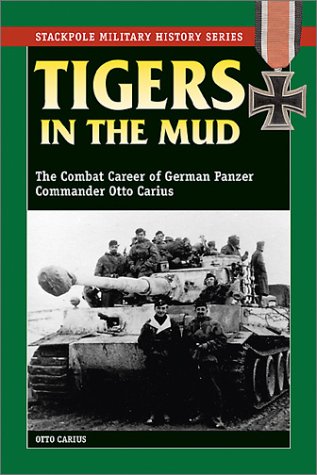 They say nobody should write books about war. The ones who weren’t there will never understand, and the ones who were there remember everything with the most brilliant hindsight a man can have.
They say nobody should write books about war. The ones who weren’t there will never understand, and the ones who were there remember everything with the most brilliant hindsight a man can have.
Tigers in the Mud is the combat memoirs of German tank commander Otto Carius. Rejected twice from the Wehrmacht for being underweight, Carius rose to become one of the most deadly men of World War II, credited with over 150 tank kills. He was awarded the Knight’s Cross, to which Himmler would affix the Oak Leaves in 1944. He served on multiple fronts, fighting “Ivan” in the east and then American soldiers crossing the Rhine. This is his story: WWII from behind the 88mm cannon of a Tiger.
Carius describes the legendary Tiger I with something like awe and something like love. They were the German answer to the Russian T34, huge, ugly, but not without some inner grace. Controlling them was easy (“It drove just like a car”, Carius says), and they could make 45kph on a road and 20kph cross-country. They packed massive firepower. Carius describes stunts such as letting an enemy hide behind a house, and then shooting them straight through the house’s walls.
It’s not all about tanks, it’s also about people, and Carius acclaims the men he fought beside (and under). He seems eager to emphasise the patriotism and camaraderie of the Wehrmacht at the front line, and says that nobody was forced into battle. Some men were Nazis, some opponents of Nazis, some motivated by nothing more political than the glory of their homeland.
Some parts are nail-biting, like when a stiff-necked Oberst orders Carius to advance into a deathtrap. Carius ends up shot once in the forearm, four times in the back, and once in the neck at point blank range.
Some parts are downright bizarre. It seems German administration was lax at writing documentation for the Tiger I. The Russians, however, published excellent guides on the Tiger I’s strengths and weaknesses. The result was a surreal process where German tank drivers had to learn about their own tanks using captured enemy literature.
Carius tells in detail of his meeting with Heinrich Himmler, who is described as calm and friendly. Himmler offers Carius a place in the Waffen-SS, which he declines. Then, in another bizarre scene, Himmler asks if Carius has seen the sights of the city, and gives him a car to go joyriding through Salzberg. The war is winding down at this point, and soon Carius tells of less happy things: the grim conditions of American prison camps where, he says, the Yankees set about proving that they were worse than the Germans. A quote stands out: “peace is hell.”
Carius was a gifted soldier but only an average writer, which is better than the alternative. Had he been a gifted writer but an average soldier he likely would have been killed, which poses great difficulties if you want to write a book.
Nevertheless, I wish there was more detail, and more elaboration. There are many amazing things in this book, but alas, we see them only as sketches. One example is found in the book’s early pages. Carius describes a tank tipping over while falling off a ramp. What happened next? How do you get a sixty ton tank back upright? Who’s job was that in the army? How badly damaged was the tank? I wish he had gone a bit deeper into some things. Tigers in the Mud is a fascinating tour through WWII, but it is a rushed one, and gunsmoke sometimes obscures the view.
No Comments »
Comments are moderated and may take up to 24 hours to appear.
No comments yet.
